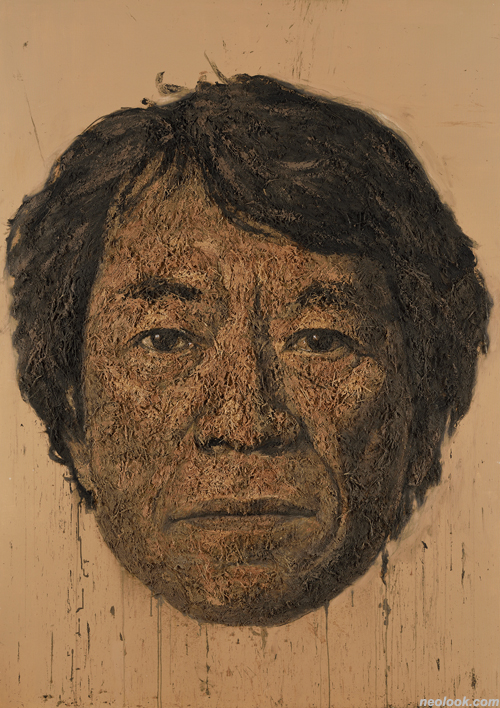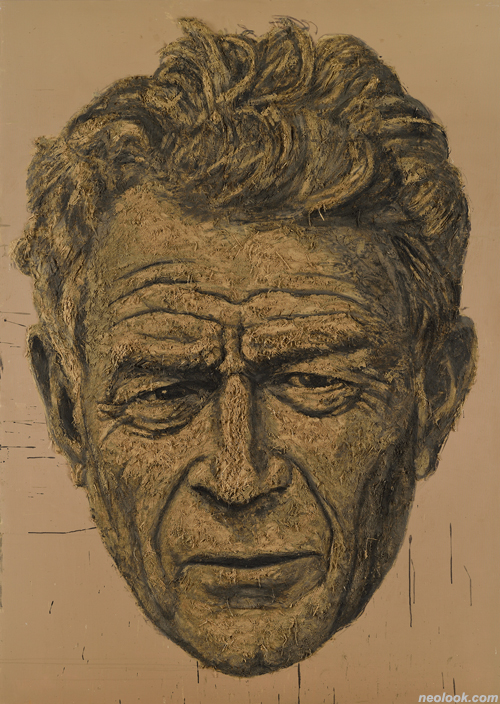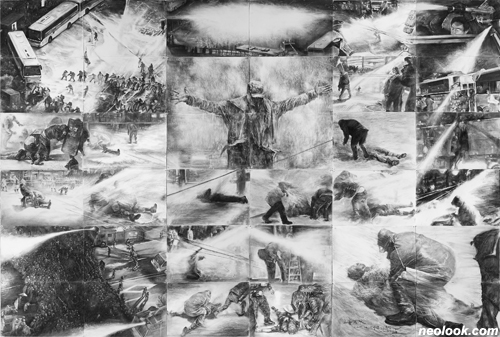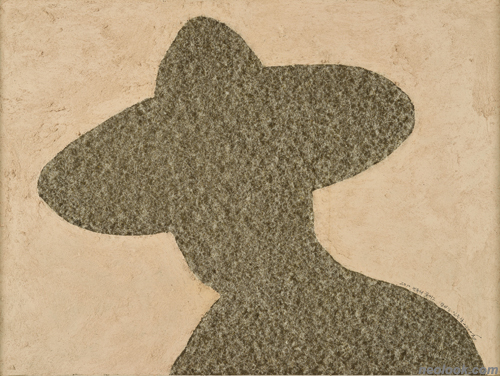- ● homepage
- ● archives
- ● restoration
- ● books
- ● big banners
- ● post board
- ■ neo's search
- ■ about us
- ■ 게재방법 안내
- 개인정보처리방침

- [email protected]
- Tel. 02_335_7922
- Fax. 02_335_7929
- 10:00am~04:30pm
- 월요일~금요일
- 3/3(월) 대체공휴일

바람 일다 The Wind Rises
임옥상展 / LIMOKSANG / 林玉相 / painting 2017_0823 ▶ 2017_0917
● 위 이미지를 클릭하면 네오룩 아카이브 Vol.20110828g | 임옥상展으로 갑니다.
초대일시 / 2017_0830_수요일_05:00pm
입장료 / 성인 3,000원 / 소인 2,000원 * 단체 20명 이상 20% 할인 * 7세 이하, 64세 이상, 장애 3급이상 무료입장 * 빌레스토랑 식사시 무료입장
관람시간 / 10:00am~07:00pm
가나아트센터 Gana Art Center 서울 종로구 평창30길 28(평창동 97번지) Tel. +82.(0)2.720.1020 www.ganaart.com
임옥상, 흙으로 흙을 말하다. ● 임옥상은 민중미술 1세대 작가로 화단에 데뷔하여 지금까지 왕성하게 작업하고 있는 현재진행형의 작가이다. 대표적 민중미술가답게 문명비판적, 정치고발적, 사회참여적 작품으로 정평을 얻고 있는 그는 정통 유화물감을 비롯해 종이 쇠 흙 등 다양한 재료를 사용하는 다매체 작가, 페인팅 조각 설치를 넘나드는 다장르 작가로 자신만의 조형세계를 구축하고 있다. 동시에 예술을 삶의 근저에 작동시키며 생활환경의 변화를 꾀하는 공공미술가, 미술의 사회적 역할과 기능에 질문을 던지며 집단참여와 대중소통을 도모하는 문화 액티비스트로서 폭넓은 활동을 펼치고 있다. ● 가나아트센터에서 열리는 임옥상의 이번 개인전 『바람 일다』展는 평면 작품이 주를 이루며 회화가 대표 장르였던 80년대 민중미술 전시풍경을 떠올리게 한다. 또한 개별 작품들이 담보하는 정치적 내용과 리얼리즘 양식에서도 역사적 민중미술을 계승하는 듯하다. 그러나 다수의 신작을 발표하고 있는 이번 전시에서는 과거의 자신이나 기존의 민중미술과 차별화되는, 지금/여기의 임옥상을 직시케하는 현재성과 참신성이 감지되고 있다. 그러한 느낌은 시의적이고 동시대적인 화두를 다루는 주제의식, 재료발굴과 방법론적 실험에 의거하는 새로운 조형의지에서 비롯되는 듯 하다. 특히 이번 출품작들이 보여주듯이, 흙 재료에 대한 사유와 성찰, 이와 함께 본격화된 흙 작업이 눈길을 끈다. 이전에도 그는 땅을 주제로 흙을 매체로 다수의 작품을 제작해 왔지만 이번 흙 작업은 흙을 물질적 재료 이상의 개념적 매체로 파악하는 작가의 인식론적 태도에서 달라 보인다. "매체는 메시지"라는 마셜 맥루언의 경구를 환기시키듯, 그는 흙이라는 매체로 흙의 메시지를 전달하는 매체예술 차원의 흙 작업을 선보이는 것이다.

- 임옥상_가면무도회_혼합재료_가변크기_2017

- 임옥상_자화상 1_캔버스에 혼합재료_259×181.8cm_2017
흙은 땅을 만드는 물질적 요소이지만 물질성을 초월하는 우주적 상징성과 문명비판적 함의를 내포하고 있다. 만물이 흙에서 소생하고 흙으로 되돌아가듯이 흙은 우주의 순환적 원리를 암시하는 지구의 살이자 뼈로 은유될 수 있다. 동시에 흙은 현대 도시문명과 대비되는 농촌문화, 민족적 저항과 민중적 힘으로 표상되는 까닭에 민중미술을 비롯한 리얼리즘 계열의 미술가들은 물론, 인간의 존엄과 소외, 낭만적 사랑과 생명사상을 중시하는 계몽주의, 민족주의 문학가들의 영감을 자극하는 으뜸 소재로 꼽혀왔다. 예컨대 이광수의 「흙」, 박경리의 「토지」, 펄 벅의 「대지」는 모두 흙과 땅에 대한 집착과 사랑을 그리며 흙, 토지, 대지에 뿌리 내린 농민과 서민들의 강인한 삶, 사회의 구조적 변화와 불가항력적 역사의 질곡 속에 내던져진 그들의 개인적 운명을 서사화한다. ● 임옥상의 흙 작업에도 위의 문학작품과 같은 역사적, 민족적, 사회적, 개인적 내러티브가 내재해 있다. 그러나 최근 그의 흙 작업은 강한 신체적 암시를 풍기며 뇌지적인 문학과는 다른 미술 장르 특유의 시각적, 촉각적 특성을 부각시키고 있다. 이러한 논점은 그가 사용하는 흙이 작업용 점토가 아니라 정제되지 않은 생흙, 벌거숭이 같은 맨흙이라는 점에서 뒷받침된다. 맨흙을 사용하는 까닭에 그의 흙 그림, 특히 1층 전시장 벽면을 장식한 흙 초상화는 흙의 끈질긴 생명력을 의인화하듯 거칠고 억세고 강인해 보인다. 영국의 혁명적 사회주의 공예운동가 윌리엄 모리스, 미술을 사회와 결부시키며 서구 소비사회의 시각문화 이데올로기를 비판한 영국의 미술비평가 존 버거 등, 자신이 존경하는 두 역사적 인물들을 그린 '오마주' 초상화는 물론, 세대와 나라는 달라도 이들과 마찬가지로 의식적, 사상적 절실함과 실천적 과제의 절박함으로 한국 군사독재정권에 통렬하게 맞섰던 임옥상 자신의 자화상 모두가 생흙이 아니면 표현할 수 없는 원초적 생경함으로 단호하고 비장한 아우라를 발산하며 관객의 오감에 어필한다.

- 임옥상_존 버거_캔버스에 혼합재료_259×182cm_2017

- 임옥상_윌리엄 모리스_캔버스에 혼합재료_259×182cm_2017
흙 초상화 연작이 걸린 1층 전시장 중앙 공간은 이승만, 박정희, 전두환, 노태우, 김대중, 노무현, 이명박, 박근혜, 문재인, 김일성, 김정은, 트럼프, 아베 등 국내외 13인의 국가 원수들의 초상을 자이언트 종이 가면으로 희화화하여 공중에 매달아 놓은 설치작품 「가면무도회」로 채워져 있다. 코믹한 만화 캐릭터 같은 이 가면 연작은 침울할 정도로 심각해 보이는 상기 문화적 인물들과 극심한 대비를 이루며 2층의 혼합매체 평면작품 「가면 박물관 - 남한」과 「가면 박물관 - 북한」과 함께 초상화의 미장센을 연출한다. ● 흙과 함께 그가 즐겨 사용하는 재료는 곡식, 꽃씨 등 흙, 땅과 관련된 자연적이고 비예술적 인 재료들이다. 2층 전시장에 진열된 노무현과 문재인 두 전/현직 대통령의 초상화 「민들레 꽃씨, 당신I」, 「민들레 꽃씨, 당신 II」는 민들레 꽃씨로 제작되었다. 강인한 생명력으로 행복과 희망을 뜻하지만 흔하고 익숙해 눈에 띄지 않는 야생화 민들레를 의인화하듯, 실루엣으로 재현된 이 상징적 초상화는 촛불 혁명을 주제화한 소위 '광화문 역사화' 「광장에, 서」와 마주하며 의미론적 대조를 이루고 있다. 이 작품에서 작가는 108개의 현장 기록사진으로 구성된 커다란 배경면에 흙으로 조형화한 무수한 원형 패턴으로 촛불파도를 묘사하고 있다. 촛불을 흙불로 환원시키며 광장의 기적과 땅의 기적, 민중의 저항과 토지의 저항을 동일시하고 있는 「광장에, 서」는 각각 용산 화재와 물대포 사건을 재현한 「삼계화택(三界火宅)」과 「상선약수(上善若水)」, 이전 정권의 적폐를 풍자적으로 재현, 비판한 유화 작품 「물밑 창조경제」와 함께 시의적, 시사적 작품군을 이루고 있다.

- 임옥상_삼계화택-불_종이에 파스텔_336×480cm_2016

- 임옥상_상선약수-물_종이에 목탄_336×480cm_2016
임옥상은 억압적 현실과 사회적 모순을 직시하고 그에 대해 발언하는 도발적이고 고발적인 민중미술가이지만, 다른 한편으로는 꿈을 좇는 비저너리이자 환상적 작품의 창조자이기도 한다. 2층 전시장 두 방에서 선보이고 있는 벽화 크기의 흙 풍경화 세 점이 바로 작가의 강렬하고 직설적인 리얼리즘 작품군과 대비되는, 초월적 숭고미학으로 관조의 여운을 남기는 환상적 알레고리화를 예증한다. 「여기, 노란꽃」, 「여기, 무릉도원」. 「여기, 흰꽃」에서 작가는 작품 상단을 청와대 뒷산 산세를 선묘로 재현하고 있지만 하단은 산 밑으로 펼쳐지는 도시 경관을 무화시키듯 만발한 꽃들로 가득 채우고 있다. 실제 풍경을 풍유적으로 번안한 일종의 관념적 실경화이자 현대판 무릉도원으로서 이 작품들은 암울한 현재를 극복하고 희망찬 내일로 나아가고자 하는, 미래의 신세계를 향한 작가의 유토피안 드림을 대변한다. ● 이번 전시 『바람 일다』展에서 작가는 흙을 주매체로 회화사, 특히 리얼리즘 미술의 두 대표 장르라고 할 수 있는 인물화와 풍경화를 집중적으로 제작, 발표하고 있다. 그의 인물화는 실제 역사적 인물을 재현하는 점에서 인물화이기보다는 초상화이며. 그의 풍경화는 역사적 사실이나 정치적 사건 혹은 실제 장면을 대상화하고 있는 만큼 실경화이다. 이번 전시 『바람 일다』展는 초상화로 시작되고 실경화로 끝을 맺는다. 전술한 흙 초상화 연작이 전시를 여는 프롤로그라면 흙 실경화 연작은 전시를 맺는 에필로그에 해당된다.

- 임옥상_민들레 꽃씨 당신 1_캔버스에 혼합재료_97.5×130.5cm_2017

- 임옥상_민들레 꽃씨 당신 2_캔버스에 혼합재료_194×130.5cm_2017
임옥상은 땅, 대지, 자연, 역사에 천착하는 민중미술가답게, 흙으로 초상화를, 실경화를 그린다. 그에게 흙은 정치사회적 의식과 민중적 저항의 기표로 의미화되고 있지만 동시에 그것은 현실과 이상, 실재와 상상의 세계를 왕래하는 그 자체가 환상적 매트릭스가 된다. 공격적이기보다는 방어적이고 수용적인 매트릭스로서의 흙, 땅, 토지, 대지는 라틴어 어머니 mater와 자궁 ix의 합성어인 매트릭스가 시사하듯이, 국가, 민족, 사회, 개인이 태어나고 성장, 발전하는 생명의 젖줄이자 모성적 태반이다. 작가는 흙에 대한 경의로 모체적 매트릭스로 회귀하고 그곳에 뿌리를 내리고자 한다. 그리하여 흙의 자정능력으로 스스로 깨어있는 작가, 행동하는 인간이기를 갈구하며, 객토客土의 고행으로 자신을 변화시키고 세상을 혁신하고자 한다. ■ 김홍희

- 임옥상_광장에 서_캔버스에 혼합재료_각 360×1620cm_2017
Lim Ok-Sang Talks About Earth With Earth ● Lim Ok-Sang is a progressive contemporary artist, who made his debut as a first-generation artist of the Minjung art movement, and continues to work vigorously even today. Like any other representative Minjung artist, he has earned a reputation for making works that criticize civilization, expose political malice, and participate in society. He is also a multi-media and multi-genre artist, who uses diverse materials such as paper, metal and earth in addition to oil paints, and freely crosses the borders of painting, sculpture and installation, as he builds his unique formative world. His broad scope of activities also include public art, aiming to change people's living environment by introducing art into the very foundations of life, and cultural activism, which seeks collective participation and mass communication while questioning the social roles and functions of art. ● Lim Ok-Sang's solo exhibition The Wind Rises, which is to be held at Gana Art Center, will consist mainly of two-dimensional works, reminding us of the Minjung art scene of the 80s, when painting was the representative art genre. The political contents of the individual works, and their realist style also seem to historically succeed Minjung art. But in this exhibition, where numerous new works will be presented, we can sense a certain nowness and freshness enabling us to look straight at the Lim Ok-Sang here and now, which is different from what he used to be, different from the former Minjung art. Such feeling seems to come from his awareness of subject in dealing with timely and contemporary topics, and new formative will executed through experimentation of materials and methodology. As shown in the entries, his full-fledged earth works, which demonstrate contemplation and reflection on soil as material, draw particular attention. Though he has also produced numerous works based on the theme of land using dirt as a medium, his recent earth works seem different, particularly in terms of the artist's epistemological attitude of seeing earth as not only a physical material, but a conceptual medium. As to evoke Marshal McLuhan's epigram, "The medium is the message," Lim presents soil works in the dimension of media art, which convey the message of the earth through the medium of earth. ● Though earth is a physical element composing the land, it contains cosmic symbolism and critical connotations of civilization that transcend materiality. As all things are born from dirt and return to it, dirt can be seen as a metaphor of the flesh and bones of the Earth, suggesting the principle of circulation of the universe. Meanwhile, since earth has been used as a symbol of rural culture in contrast with modern urban civilization, and as national resistance and power of the people, it has also been one of the prima subject matter that most inspired not only artists of Minjung art and other schools of realism, but also writers of enlightenment and nationalist literature who emphasized on the romantic love and idea of life. For example, Lee Kwang-Soo's Earth, Park Kyoung-Ni's Toji (Land) and Pearl Buck's The Good Earth all portray the attachment to and love for the soil and land, narrating the resilient lives of farmers and ordinary people rooted in the land, and the destiny of individuals thrown into the situation of structural change in society, and the uncontrollable ordeals of history. ● Such historical, national, social and personal narratives mentioned above also exist in Lim's earth works. His recent works, however, give off strong physical suggestions, thus bringing into relief visual and tactile characteristics unique to the genre of visual art, different from cerebral literature. This point is supported by the fact that the earth he uses is not modeling clay, but unrefined raw soil, the naked bare dirt. Because he uses raw soil, his earth pictures—particularly the earth portraits decorating the walls of the first-floor exhibition hall—appear rough, tough and powerful, as if to symbolize the resilient life force of earth. Not only the homage portraits to the two historical figures he admires—the revolutionary socialist craft activist William Morris of Britain, and British art critic John Berger, who criticized the visual culture ideology of Western consumer society by connecting art to society—but also a self-portrait of the artist himself who fiercely opposed the military dictatorship of Korea with poignancy of consciousness and ideology, and urgency of tasks at hand, appeal to the senses of spectators with determined and tragic aura, with an original strangeness that could not have been expressed in anything other than raw dirt. ● The central space of this first floor space is filled with the installation work, Masquerade, which caricatures the faces of 13 state leaders of the world—Rhee Syng-Man Rhee, Park Chung-Hee, Chun Doo-Hwan, Roh Tae-Woo, Kim Dae-Jung, Roh Moo-Hyun, Park Geun-Hye, Moon Jae-In, Kim Il-Sung, Kim Jong-Un, Donald Trump and Shinzo Abe—as giant paper masks hanging in mid-air. These comic cartoon-character-like masks form a drastic contrast against the above-mentioned cultural figures, who seem serious to the extent of depressed, finally producing a mise-en-scéne of portraits together with the mixed-media two-dimensional works The Mask Museum—North Korea and The Mask Museum—South Korea on the second floor. ● Some of the materials Lim enjoys using together with earth are natural and non-artistic materials such as grain and flow seeds, which are lined to earth or the land. The portraits of former President Roh Moo-Hyun and current President Moon Jae-In—Dandelion Seed, You I, and Dandelion Seed, You II—were made with flower seeds. The symbolic portraits represented as silhouettes, as if to personify the wild dandelion, which is known for its strong life force, means happiness and hope, but is also so common it goes unnoticed, are placed face-to-face with Tide of Candles—a so-called 'Gwanghwamoon historical painting'—creating a semantic contrast. In this work, the artist depicts tides of candles in countless round patterns formed with earth on a gigantic background composed of 108 documentary photographs taken at the site. Tide of Candles, which equates the miracle of the plaza with the miracle of the land, the resistance of the minjung with the resistance of the land, while reducing the candle lights into earth fire, is part of Lim's group of timely and political works along with The Anguish of Life Is Like a Burning House-Samgyehwataek and The Greatest Good Is Like Water-Sangseonyaksu, which represent the Yongsan burning incident and water cannon incident, respectively, and with the oil painting The Creative Economy Under Water, which is critical satires of the deep-rooted evils of previous governments. ● Though Lim Ok-Sang is a provocative and accusing Minjung artist who sees through and criticizes the oppressive reality and social contradictions, on the other hand, he is also a dream-chasing visionary and creator of fantastic works. The three earth landscape paintings of mural scale to be shown in the two rooms on the second floor exemplify his fantastic allegory paintings which leave lingering contemplative impressions achieved through transcendental sublime aesthetics—a stark contrast with the artist's powerful, direct and realistic body of work. In Here, Yellow Flower, Here, Paradise, and Here, White Flower the artist represents the mountains behind the Blue House on the upper part of the pictures through line drawings; however, he fills the lower parts with flowers in full bloom as if to nullify the urban landscape spread out below the mountains. These works, as a kind of ideal real view painting translating actual landscape into allegory, and as a contemporary paradise painting, represent the artist's utopian dream toward a new world of hope in the future by overcoming the dark present. ● In the exhibition The Wind Rises, the artist will use earth as his main medium to make and present mainly figure painting and landscape painting, which are the two pivotal genres in the history of painting, particularly realist painting. His figure paintings are rather portraits as they represent actual historical figures, and his landscape paintings are real-scene paintings as they deal with historical facts, political events and actual scenes. Wind Rises begins with portraits and ends with real-landscape painting. While the aforementioned earth portrait series is the prologue that opens the exhibition, the earth real-landscape painting series is the epilogue completing the exhibition. ● As a Minjung artist, who tirelessly inquires on the earth, land, nature and history, Lim Ok-Sang paints portraits and landscapes with earth. For him earth is used as a signifier of political-social awareness and resistance of the people, but at the same time it also functions as a fantastic matrix that traverses the worlds of the real and ideal, the worlds of real and imaginary. The earth and land as a matrix that is defensive and accepting rather than aggressive—as suggested by the word's composition of mater(Latin for mother) and ix(womb)—is the lifeline of life and the maternal placenta enabling the state, nation, society and individual be born, grow and develop. In respect for earth, the artist intends to return to the matrix and take root there. Hence, while yearning to be an artist awake with the self-purifying ability of soil and a man of action, Lim Ok-Sang tries to change himself and innovate the world through the discipline and painstaking practice of transporting soil. ■ Kim Hong-hee
Vol.20170823f | 임옥상展 / LIMOKSANG / 林玉相 / painting

